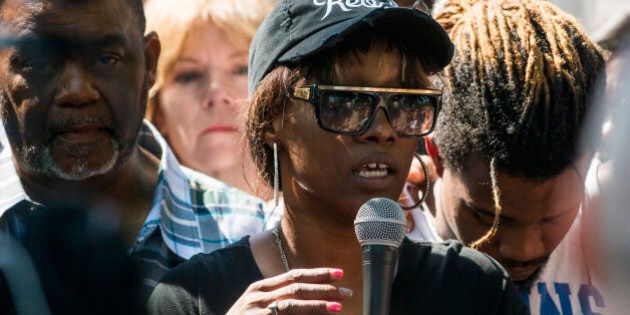
Diamond Reynolds speaks to a crowd outside the Governor's Mansion in St. Paul, Minnesota. (Photo by Stephen Maturen/Getty Images)
Not since the early '90s, in a "Town Hall Meeting" broadcast on live television and moderated by then-ABC-anchor Ted Koppel, have I heard so much pain, so much unadulterated Truth, and so much raw conviction coming from a grieving Black woman in the U.S.
The aim of that Town Hall format was to let people vent in a controlled environment that allowed multiple viewpoints, after the post-verdict Rodney King riots in Los Angeles that had reopened the racial wound (in April 1992, four White police officers were acquitted of Rodney King's brutal beating, despite a video that was taken of the beating).
During that broadcast, a woman called in to share her experience. Her son had been killed by police. She spoke about her South Central Los Angeles reality with such impassioned clarity that no one could speak after her, and Koppel had to cut to a commercial break. That was the first time America seemed to be learning something about itself, confronted by a stinging reality that was foreign to most.
No one would know his name today if someone hadn't recorded a video showing him receiving the blows. That person made history at that moment. Because the video told the real story on behalf of Rodney King.
Today, 24 years later, Diamond Reynolds, the girlfriend of Philando Castile who was shot by police July 6 in Minnesota and died in her car in front of her 4-year old daughter, is saying exactly the same thing, with the same emphatic words, the same strength and resilience, making perfect sense despite the trauma and sleep deprivation that would have floored any of us, saying the same immaculate truth about a reality many have long known, and that others will still not see. It's still about fear, hatred, and the institutionalized absence of respect.
"They [police officers] are damaged from all the previous people they have killed. [...] They were for each other, every single department. [...] I am Trayvon Martin. You are Trayvon Martin. We are the people. We can't keep allowing these people who are supposed to serve and protect us, to take us away from our family, away from our loved ones, away from our children."
But beyond the horror and pain in both cases and so many others, it is the person holding the video camera who is providing the crucial third party, the irrefutable witness who allows the event to be known outside of police dockets. Rodney King became a symbol of resistance to police brutality in 1991, but no one would know his name today if someone hadn't recorded a video showing him receiving the blows. That person made history at that moment. Because the video told the real story on behalf of Rodney King.
But beyond the horror and pain in both cases and so many others, it is the person holding the video camera who is providing the crucial third party, the irrefutable witness who allows the event to be known outside of police dockets.
"Without video, this kind of shooting might be an item in a local police blotter." -- New York Times, July 7 2016
Today, video broadcasts by individuals are putting the facts in the hands of "The People", supplanting traditional media and perhaps even the legal process, and putting pressure on those who have systematically changed the facts to rewrite history in their favour.
She banked on live video to be the only unbiased witness she could count on.
Diamond Reynolds had the sense to use Facebook Live "to make the world see." In so doing, she changed the course of communication. By broadcasting to the global community how things happen in real life. By forcing the inevitable conversation at home. By leveling the playing field. Socially. Legally. Morally. Changing perceptions. Showing a Truth that can't be argued or dismissed.
Diamond's incredible endurance, intelligence, and lucidity are a tribute to the perpetual struggle and spirit of this community to simply exist. In a fight-or-flight situation, she banked on live video to be the only unbiased witness she could count on. She put all her chips on that. And changed history.
Follow HuffPost Canada Blogs on Facebook
ALSO ON HUFFPOST:
Follow HuffPost Canada Blogs on Facebook